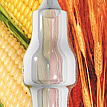
It resembles clear polystyrene, provides good aesthetics (gloss and clarity), but it is stiff and brittle and needs modifications for most practical applications (i.e. plasticizers increase its flexibility).
It can be processed like most thermoplastics into fibres, films, thermoformed or injection moulded.
Used for compost bags, plant pots, diapers and packaging.
Category
Products
Processes
Blow moulding
Injection moulding
Extrusion
Vacuum forming
Fibre spinning
References
Cargill Dow Polymers LLC
Price
Environmen- tal notes
Disposal: If composted properly it takes 3-4 weeks for complete degradation.
The first stage of degradation (two weeks) is a hydrolisis to water soluble oligomers and lactic acid. The latter, as a naturally occurring substance, is a rapid metabolisation into CO2, water and biomass by a variety of micro-organisms.
Additional Info
Photo
Copyright
This page is part of Design inSite
Disclaimer